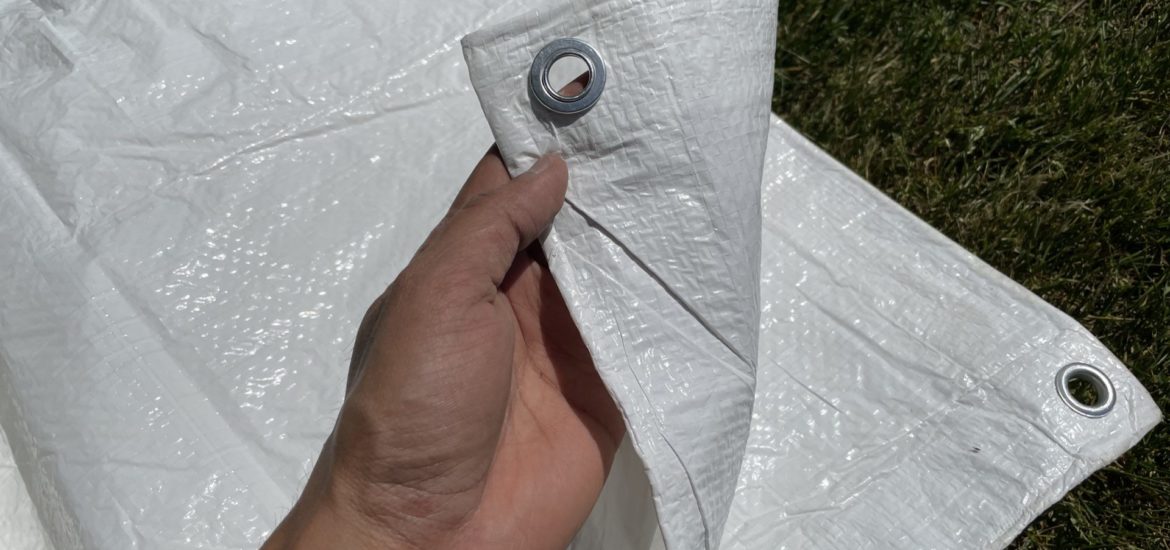Utilizing a tent footprint, also known as a ground sheet or ground cloth, helps to protect a tent’s base from water infiltration and wear, but can you use a tarp as a tent footprint?
Well, if implemented correctly, a tarp can absolutely be used as a tent footprint.
Let’s dive into what makes a tarp a suitable tent footprint, and what you should do when setting up your tent.
Article Contents:
Why Using a Tent Footprint is a Good Idea

Extra Layer of Protection Against Wear
The base of your tent will most likely see the most wear over the course of its use.
That’s because setting up your tent on rough ground, sharp twigs, and rocks can (and will) slowly cause the base material to breakdown through abrasion.
- Over time, micro-tears can develop, and the water-repellent (DWR) coating can wear away, leading to water penetration during wet weather
Good tent manufacturers typically intrinsically use higher strength and durable materials for tent bases. But, no tent is 100% safe from failure.
So, by using a tent footprint you’re essential adding an extra layer of protection between your tent and the ground. In essence, a footprint acts as a sacrificial layer to take on the brunt of the abuse, which can be replaced relatively inexpensively.
Improved Water Resistance
As mentioned previously, micro-tears and the wearing away of the waterproof coating on the tent base can lead to water infiltration.
So, to combat this issue, a tarp placed on the ground before setting up your tent can dramatically improve the resistance to water penetration.
Waterproof vs. Water-Resistant Tarps
There’s a big difference between “waterproof” and “water-resistant” tarps. And, depending on the state of your tent base, you might need one over the other to act as a footprint.
Waterproof tarps offer complete protection from water and moisture. Waterproof tarps are made from polyvinyl chloride (PVC), vinyl laminated polyester, or vinyl coated polyester.
Water-resistant tarps repel water for a limited time, and may eventually become saturated, letting water through. Water-resistance tarps are typically made from oil or wax coated canvas, or heavy-duty ultra-violet protected polyethylene.
Which Tarp Material is Best?
Because a tent footprint isn’t directly exposed to torrential downpours, it doesn’t necessarily need to be waterproof.
Instead, a water-resistant tarp acting as a footprint is more than adequate at stopping water ingress while also providing protection against abrasion.
So, a tarp made from canvas or polyethylene would be a great tent footprint material. It’s water-repelling properties, durability, and relatively low cost make it a great choice for most campers.
Here’s a link to a great, water resistant canvas tarp as well as a polyethylene tarp on Amazon that’ll fit any budget. Just make sure you select the right size!
How to Place a Tarp Under a Tent as a Footprint

Using a tarp as a tent footprint might seem simple. Just unravel the tarp and lay on the ground before erecting your tent. It’s just that easy, right?
Well, not exactly…
Tarp Should NOT Extend Beyond Tent Base
Since tarps are designed to be an impermeable water barrier, they can also catch and collect water when it rains.
And, if water is allowed to collect on a tarp acting as a footprint, it might inadvertently pool together and penetrate into your tent… which is what you’re trying to prevent!
So, when you use a tarp as tent footprint, make sure it doesn’t extend beyond the base of your tent. Even a tarp that extends a few inches wider than your tent base can be detrimental.
- Fold the tarp so that it lays completely underneath the tent
- When it rains, water doesn’t pour down your tent and collect onto the footprint
- Water is allowed to flow onto the ground and beneath the footprint
Tent Footprint Alternatives
If you’re looking for alternative materials for a tent footprint, you may want to consider tyvek and ripstop nylon.
1. Tyvex
Tyvek is commonly used in the construction of homes as a moisture barrier. That makes it readily available, inexpensive, and perfect as a footprint material. Physically, it’s made from high-density, flash-spun polyethylene fibers.
The material and manufacturing process makes tyvex completely waterproof, yet breathable. It weighs around 0.2 ounces per square foot, so it’s relatively light-weight. This makes it popular among backpackers.
You can cut and stitch Tyvex easily, so making your own tent footprint at home can be a great DIY project! Here’s a link to a 3-meter section of Tyvex and a 5-meter section of Tyvex on Amazon.
2. Ripstop Nylon
Since most tents are made from ripstop nylon, it makes sense that you should be able to make a tent footprint out of the same material.
Polyurethane (PU) coated ripstop nylon is a popular footprint material because it’s high-strength, light-weight, and waterproof.
With the right technique and materials, you can easily make a nylon footprint at home. Here’s a link to PU coated ripstop nylon on Amazon.
This article contains affiliate links, which help support this blog at no cost to you!
